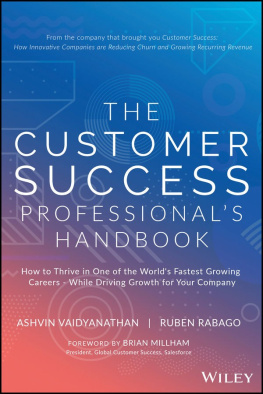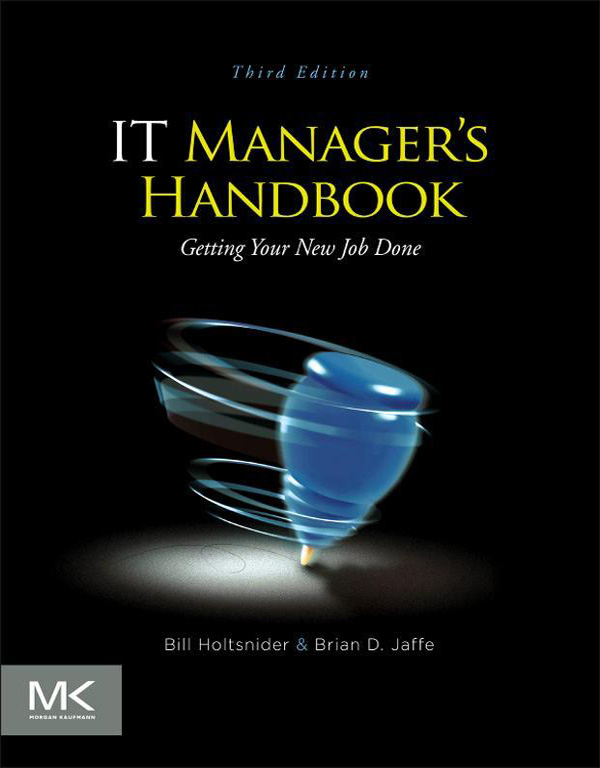IT Manager's Handbook
Getting your new job done
Third Edition
Bill Holtsnider
Brian D. Jaffe

Acquiring Editor: Andrea Dierna
Development Editor: Robyn Day
Project Manager: Jessica Vaughan
Designer: Joanne Blank
Morgan Kaufmann is an imprint of Elsevier
225 Wyman Street, Waltham, MA 02451, USA
2012 William Holtsnider & Brian D. Jaffe. Published by Elsevier, Inc. All rights reserved.
No part of this publication may be reproduced or transmitted in any form or by any means, electronic or mechanical, including photocopying, recording, or any information storage and retrieval system, without permission in writing from the publisher. Details on how to seek permission, further information about the Publisher's permissions policies and our arrangements with organizations such as the Copyright Clearance Center and the Copyright Licensing Agency, can be found at our website: www.elsevier.com/permissions.
This book and the individual contributions contained in it are protected under copyright by the Publisher (other than as may be noted herein).
Notices
Knowledge and best practice in this field are constantly changing. As new research and experience broaden our understanding, changes in research methods or professional practices, may become necessary. Practitioners and researchers must always rely on their own experience and knowledge in evaluating and using any information or methods described herein. In using such information or methods they should be mindful of their own safety and the safety of others, including parties for whom they have a professional responsibility.
To the fullest extent of the law, neither the Publisher nor the authors, contributors, or editors, assume any liability for any injury and/or damage to persons or property as a matter of products liability, negligence or otherwise, or from any use or operation of any methods, products, instructions, or ideas contained in the material herein.
Library of Congress Cataloging-in-Publication Data
Holtsnider, Bill, 1956
It manager's handbook : getting your new job done / Bill Holtsnider, Brian D. Jaffe. 3rd ed.
p. cm.
Summary: This book provides a practical reference that you will return to again and again in an ever-changing corporate environment where the demands on IT continue to increase. Make your first 100 days really count with the fundamental principles and core concepts critical to your success as a new IT Manager outlined in this valuable resource. The book also discusses how to work with your customers, manage your budget, develop an overall IT strategy and demonstrate the value of IT to the company Provided by publisher.
ISBN 978-0-12-415949-5 (pbk.)
1. Industrial managementData processing. 2. Management information systems. I. Jaffe, Brian D. II. Title.
HD30.2.H657 2012
004.068dc23
2011044174
British Library Cataloguing-in-Publication Data
A catalogue record for this book is available from the British Library.
ISBN: 978-0-12-415949-5
Printed in the United States of America
12 13 14 15 16 10 9 8 7 6 5 4 3 2 1

For information on all MK publications visit our website at www.mkp.com
For M & D
B.H.
For Jenine
B.D.J.
About the Authors
Bill Holtsnider is an experienced writer, educator, and software professional with more than 27 years of experience working in the computer industry. His IT expertise includes working in such diverse areas as stock portfolio management, identity management, Web analytics, and software development. He is the author of six books and a wide range of technical and marketing documentation.
Brian D. Jaffe is an IT professional who has worked for several Fortune 500 companies including Bristol-Myers Squibb, Time Warner, Philip Morris, and The Interpublic Group of Companies. Currently he is Senior Vice President for Global IT at McCann Worldgroup in New York City, one of the country's leading advertising agencies. His articles have appeared in Computerworld, InfoWorld, eWeek, and The New York Times, and he is the editor of Thanksgiving Tales: True Stories of the Holiday in America.
Key Changes for This Edition
Technology has the shelf life of a banana.
Scott McNealy
IT ain't what it used to be. When we starting writing the first edition of this book, large hard drives were measured in megabytes, the World Wide Web was just getting started, and everyone's phone was tied to copper wires. If you wanted to locate a piece of information, you looked it up in a book. And technology was the exclusive purview of IT.
Thirteen years later, portable terabyte drives are sold as consumer items. The Web is beyond pervasive. Phones arewell, making calls is now just an incidental feature of what they can do. Paper books are outsold by ebooks. And terms like IP addresses, Wi-Fi, and Bluetooth are no longer the jargon of just tech-heads.
Major Change: Principles and Core Concepts
For these reasons, we have decided to make the third edition of this book about the principles and core concepts of the new IT Manager's job. There are lots of recently-minted IT Managers and they still need to learn important things like how to hire ().
IT Managers may also need to learn about converting their network to IPv6, or how to optimize a SQL database, but they will go to other sources for that information, like the Web, or training. Or they will go to books dedicated to very specific subjects, not to a general book like this one. The fundamental concepts of management do not change, although technical details dowhich is why we have decided not to include the technical material from the first two editions.
Another Major Change: Connectivity
Another major change is the addition of . This is the fastest growing area in IT, and in addition to new hardware and software considerations, it also means new ways of thinking about IT in general.
Back in the old days (just a few years ago!) scalability was the issue, not mobility. Now most data needs to be accessed almost all the time from almost anywhere. As a consequence, discussions about the mobile workforce are interspersed throughout the book. For many users, if it cannot be done from a handheld device (e.g., phone or tablet), it's not worth doing.
Regardless of the correctness of that sentiment, that is clearly the direction organizations of all sizes are heading. And, as a new IT Manager, you should be embracing this trend. Rather than being caught flat-footed when someone asks you about accessing sales data from a tablet device, you should be prepared with an answer. They might not like the answer you give them, but you'll be much better served if you have a meaningful response ready.
Lastly, we've expanded the material on cloud computing to reflect the growing shift in the industry to move functions (e.g., server, storage, applications) to service providers and reduce the investment in on-premise infrastructure.









